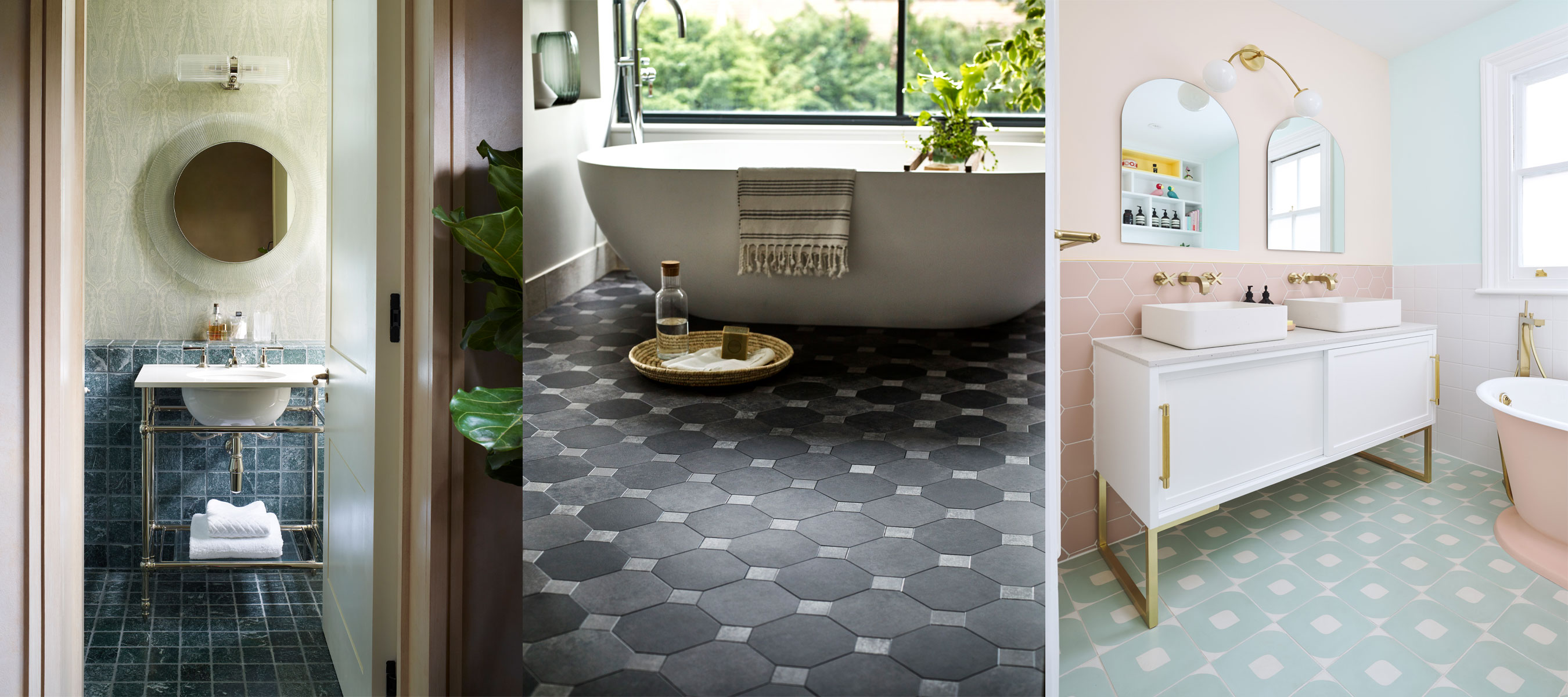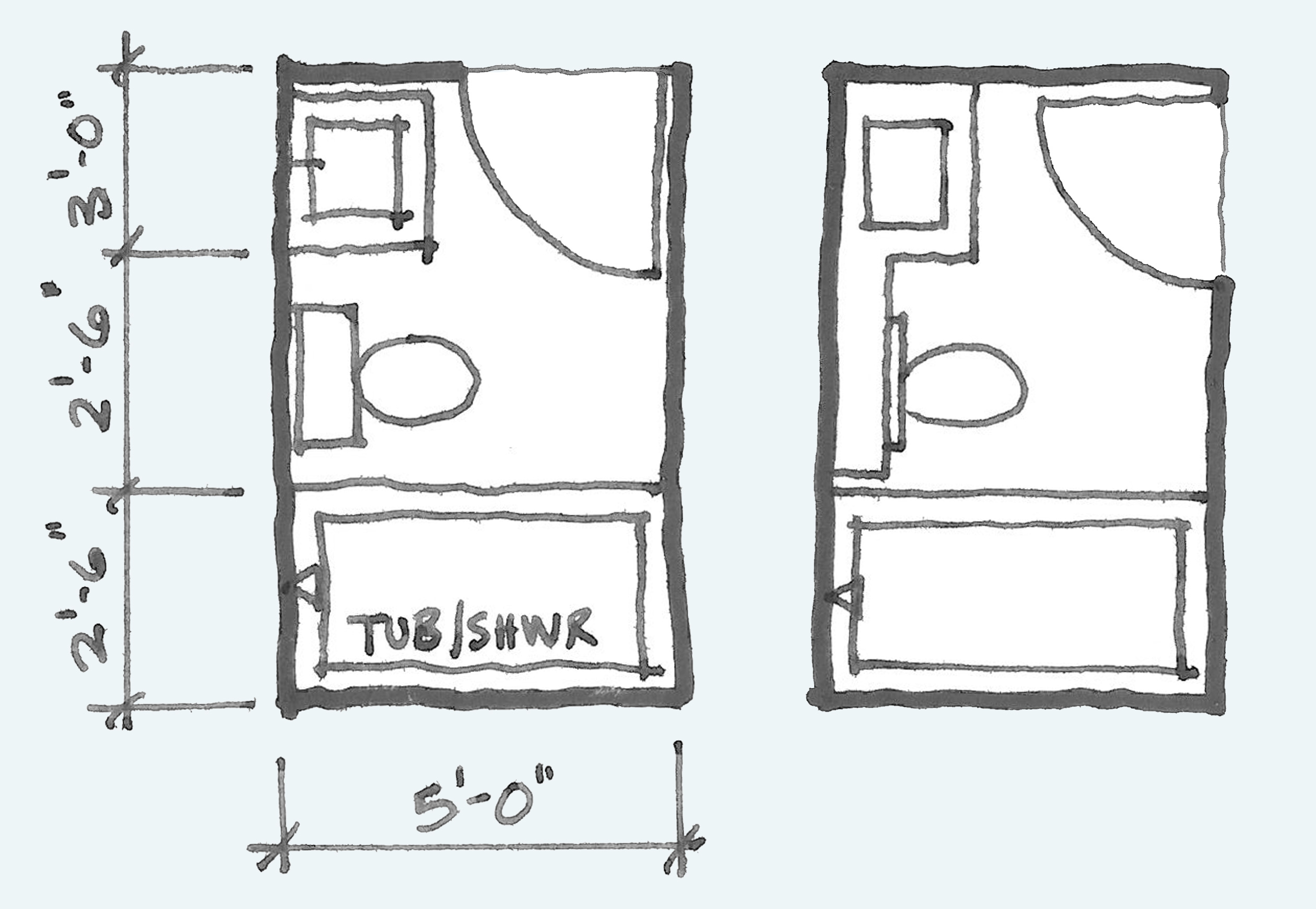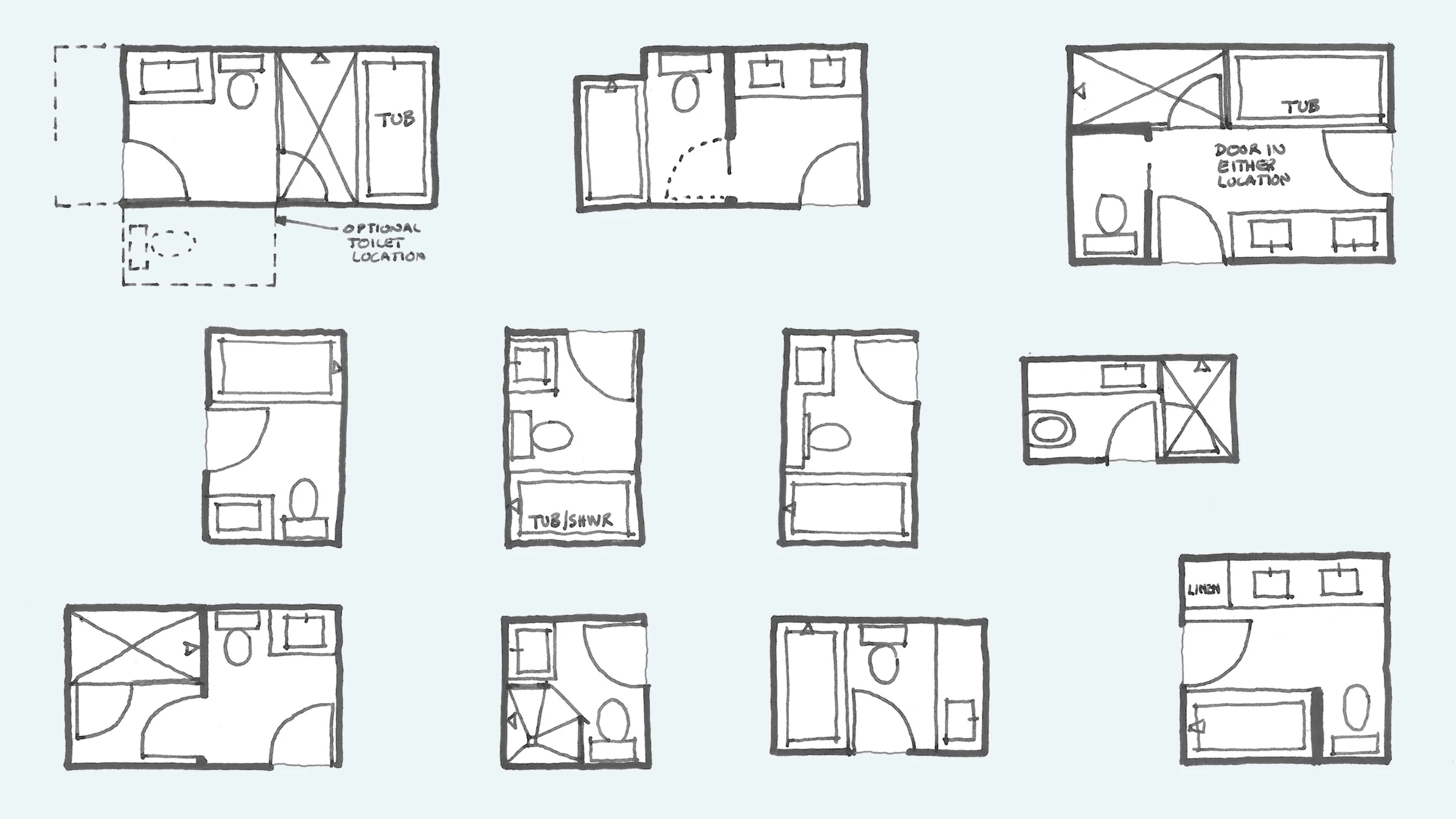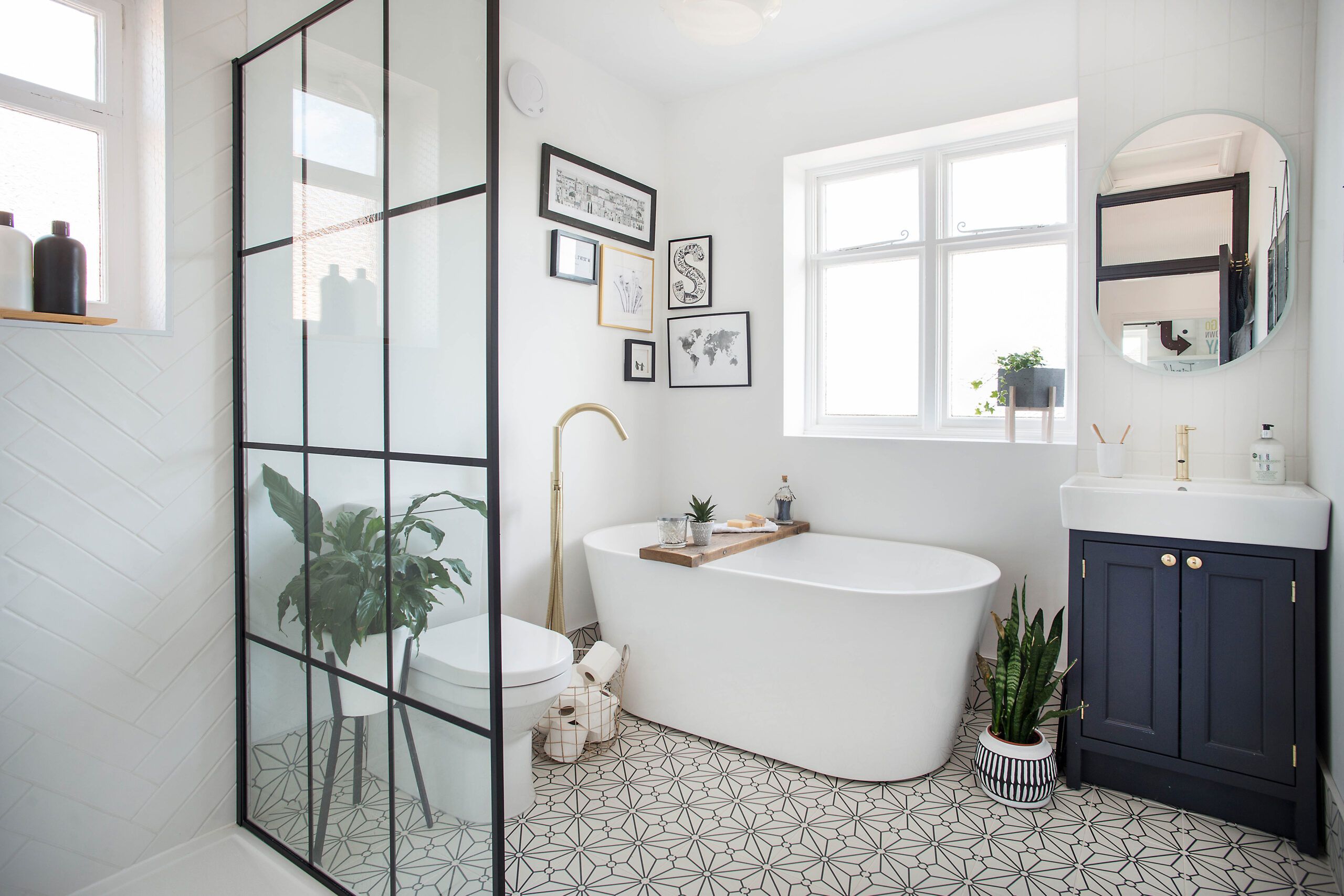Material Choices: Creative Bathroom Floor Ideas

Choosing the right bathroom floor material is crucial, as it impacts both aesthetics and functionality. The ideal material should be durable, moisture-resistant, easy to clean, and complement the overall bathroom design.
Popular Bathroom Floor Materials
The selection of bathroom floor materials is diverse, offering a wide range of options to suit different preferences and budgets.
- Ceramic Tile: A classic and versatile choice, ceramic tile is highly durable, water-resistant, and easy to clean. It comes in a wide variety of colors, patterns, and sizes, allowing for endless design possibilities.
- Porcelain Tile: Known for its exceptional durability and resistance to scratches and stains, porcelain tile is a popular choice for high-traffic areas. It also boasts a wide range of styles and finishes, including wood-look porcelain tile.
- Natural Stone: Natural stone, such as marble, granite, and slate, adds a touch of elegance and sophistication to any bathroom. It is highly durable and resistant to moisture, but can be more expensive than other options.
- Vinyl Plank: Vinyl plank flooring offers a cost-effective alternative to natural wood or tile. It is waterproof, durable, and easy to install, making it a popular choice for busy families.
- Luxury Vinyl Tile (LVT): LVT is a premium type of vinyl flooring that mimics the look and feel of natural materials like wood, stone, and ceramic tile. It is highly durable, water-resistant, and easy to maintain.
Pros and Cons of Different Materials
Each bathroom floor material has its own set of advantages and disadvantages, which should be carefully considered before making a decision.
Ceramic Tile
- Pros: Durable, water-resistant, easy to clean, wide variety of colors, patterns, and sizes, affordable.
- Cons: Can be cold to the touch, grout lines can be difficult to clean, susceptible to cracking under heavy weight.
Porcelain Tile
- Pros: Highly durable, scratch-resistant, stain-resistant, water-resistant, wide variety of styles and finishes, easy to clean.
- Cons: Can be cold to the touch, grout lines can be difficult to clean, more expensive than ceramic tile.
Natural Stone
- Pros: Elegant and sophisticated, durable, moisture-resistant, adds value to the home.
- Cons: Can be expensive, requires sealing to prevent staining, can be cold to the touch, susceptible to scratches and chips.
Vinyl Plank
- Pros: Affordable, waterproof, durable, easy to install, available in various styles and colors.
- Cons: Can be less durable than tile or stone, may not be as aesthetically pleasing as natural materials.
Luxury Vinyl Tile (LVT)
- Pros: Highly durable, water-resistant, easy to maintain, mimics the look and feel of natural materials, available in a wide range of styles and finishes.
- Cons: Can be more expensive than traditional vinyl plank, may not be as durable as tile or stone.
Bathroom Floor Design Ideas
Creating a visually appealing and functional bathroom floor involves careful consideration of material choice, color, pattern, and layout.
Modern Bathroom
A modern bathroom often features sleek lines, minimalist design, and a neutral color palette. For a modern bathroom floor, consider using large-format porcelain tiles in a neutral color like white, gray, or black. To add a touch of interest, you can incorporate geometric patterns or accents of metallic finishes.
Rustic Bathroom
A rustic bathroom embraces natural elements and textures, creating a warm and inviting atmosphere. For a rustic bathroom floor, consider using natural stone tiles like slate or travertine in earthy tones. You can also incorporate wood-look porcelain tiles or vinyl plank flooring to complement the rustic aesthetic.
Minimalist Bathroom
A minimalist bathroom emphasizes simplicity and functionality. For a minimalist bathroom floor, choose a single material in a neutral color, such as white or gray ceramic tile or large-format porcelain tiles. Avoid patterns or intricate designs to maintain a clean and uncluttered look.
Color and Pattern

The choice of color and pattern for your bathroom floor can significantly impact the overall ambiance and aesthetic appeal of the space. Colors can evoke specific emotions and create a sense of spaciousness or intimacy, while patterns can add visual interest, define areas, and enhance the bathroom’s style.
Color and Ambiance
Color plays a crucial role in shaping the mood and atmosphere of a bathroom. Certain colors are known to create a sense of relaxation and tranquility, while others can energize and invigorate. For instance, calming colors like blue and green are often used in bathrooms to create a spa-like ambiance, while warmer colors like yellow and orange can bring a sense of warmth and energy.
Here are some examples of color palettes that complement various bathroom styles:
- Modern: Neutral colors like white, gray, and black create a clean and minimalist aesthetic. You can add pops of color with accents like towels or accessories.
- Traditional: Warm tones like beige, cream, and brown are classic choices for a traditional bathroom. You can incorporate accents of gold or silver for a touch of elegance.
- Rustic: Earthy colors like brown, green, and terracotta are perfect for creating a rustic and cozy ambiance. You can also use reclaimed wood for a more natural feel.
- Coastal: Cool colors like blue, green, and white are ideal for a coastal bathroom. You can add accents of sand, coral, or seashells for a beachy feel.
Pattern and Space Definition
Patterns can be used to create visual interest and define spaces within a bathroom. For instance, a patterned floor tile can help to visually separate the shower area from the rest of the bathroom.
- Geometric Patterns: Geometric patterns, such as squares, triangles, and hexagons, are versatile and can be used to create a variety of looks. For example, a black and white checkerboard pattern can add a touch of classic elegance to a bathroom, while a bold geometric pattern in bright colors can add a contemporary flair.
- Floral Patterns: Floral patterns are a classic choice for bathrooms, especially those with a traditional or romantic style. They can add a touch of femininity and elegance to the space. However, it’s important to choose a floral pattern that complements the overall style of the bathroom.
- Abstract Patterns: Abstract patterns can add a touch of whimsy and sophistication to a bathroom. They are a great option for creating a modern or eclectic look.
Color and Pattern Scheme for a Beachy Bathroom
For a beachy bathroom, consider a color scheme that reflects the calming colors of the ocean and sand. A light blue or gray floor tile with a subtle wave pattern can create a serene and relaxing atmosphere. You can then add pops of color with accessories like towels, rugs, and artwork in shades of coral, turquoise, and sand.
Tip: To create a cohesive look, use the same colors and patterns in the shower curtain, towels, and accessories.
Layout and Design
The layout of your bathroom floor tiles can significantly impact the overall look and feel of the space. Choosing the right layout can enhance the room’s aesthetics, functionality, and even create an illusion of larger space.
There are several popular bathroom floor layout options, each with its unique advantages and disadvantages.
Traditional Layout
The traditional layout is the most common and straightforward, with tiles placed in a straight, rectangular pattern. It’s simple to install and works well with various tile shapes and sizes.
Benefits:
- Easy to install and maintain.
- Creates a clean and classic look.
- Works well with various tile shapes and sizes.
Drawbacks:
- Can be visually boring.
- Doesn’t add much visual interest.
Diagonal Layout
A diagonal layout involves placing tiles at a 45-degree angle, creating a dynamic and visually appealing effect. This layout can make a small bathroom feel larger by drawing the eye towards the corners.
Benefits:
- Adds visual interest and dynamism to the space.
- Can create an illusion of larger space.
- Can hide imperfections in the subfloor.
Drawbacks:
- More challenging to install than a traditional layout.
- May require more tiles to cover the same area.
- Can make the room feel less spacious if the tiles are small.
Herringbone Layout
The herringbone layout features tiles arranged in a V-shaped pattern, resembling the bones of a fish. This layout creates a sophisticated and elegant look, often used in high-end bathrooms.
Benefits:
- Creates a sophisticated and elegant look.
- Adds visual interest and texture to the space.
- Can be used with various tile shapes and sizes.
Drawbacks:
- Can be challenging to install, requiring precise cuts and measurements.
- May require more tiles to cover the same area.
- Can be visually overwhelming in small bathrooms.
Maximizing Space and Creating Flow
To maximize space and create a sense of flow in your bathroom, consider the following layout strategies:
- Use light-colored tiles to reflect light and make the room feel larger.
- Choose tiles with a smooth finish to create a sense of spaciousness.
- Avoid using too many different tile sizes and shapes, as this can create a cluttered look.
- Use a diagonal layout to draw the eye towards the corners and make the room feel larger.
- Create a focal point with a patterned tile or a rug to draw attention to a specific area of the bathroom.
Texture and Finish

The texture and finish of your bathroom floor tiles play a significant role in defining the overall aesthetic and feel of the space. From smooth and sleek to textured and rustic, the choice of finish can dramatically impact the ambiance, making it feel luxurious, spa-like, or contemporary.
Creative bathroom floor ideas – Beyond the visual appeal, texture also impacts practicality. Smooth finishes are generally easier to clean, while textured surfaces can offer better slip resistance, which is especially important in a bathroom where water is frequently present.
Smooth Finishes
Smooth finishes are characterized by their lack of texture, creating a clean and polished look. They are often associated with modern and contemporary bathroom designs, where simplicity and elegance are key.
- Polished porcelain tiles are a popular choice for smooth finishes, offering a glossy, reflective surface that enhances the brightness of the bathroom. They are durable and easy to clean, making them a practical choice for high-traffic areas.
- Glazed ceramic tiles also offer a smooth finish, with a wide range of colors and patterns available. They are generally less expensive than porcelain tiles but may not be as durable.
Smooth finishes can be a great option for creating a sense of spaciousness in smaller bathrooms, as the lack of texture helps to reflect light and minimize visual clutter.
Textured Finishes, Creative bathroom floor ideas
Textured finishes add depth and visual interest to bathroom floors. They can range from subtle variations to bold patterns, creating a tactile experience that enhances the overall ambiance.
- Matte porcelain tiles offer a slightly textured surface, providing a more understated look compared to polished finishes. They are still easy to clean but offer a more subtle visual appeal.
- Relief tiles feature raised patterns or designs, creating a distinct tactile experience. They are often used to add a touch of elegance or to create a specific theme, such as a Moroccan or rustic design.
- Mosaic tiles are small tiles arranged in patterns, creating a textured surface with a unique visual appeal. They are often used to create focal points or to add a touch of artistry to the bathroom floor.
Textured finishes can also provide better slip resistance, making them a safer option for bathrooms, especially for families with young children or elderly individuals.
Embossed Finishes
Embossed finishes are created by pressing a design into the tile surface, creating a raised pattern that adds depth and dimension. They are often used to create a luxurious or sophisticated feel, mimicking the look of natural stone or wood.
- Embossed porcelain tiles can mimic the look of natural stone, such as marble or granite, with a more affordable price tag. They offer a luxurious look without the high cost and maintenance of natural stone.
- Embossed ceramic tiles can also create a range of textures, from subtle variations to bold patterns. They are a versatile option, offering a wide range of styles and price points.
Embossed finishes can add a touch of elegance and sophistication to any bathroom, creating a space that feels luxurious and inviting.
Incorporating Varying Textures
To create a bathroom floor design with depth and visual interest, consider incorporating varying textures.
- Create a focal point: Use textured tiles to create a focal point in the bathroom, such as a patterned area around the vanity or a border along the walls. This can add visual interest and break up the monotony of a single texture.
- Use contrasting textures: Combine smooth and textured tiles to create a dynamic and visually appealing floor. For example, you could use smooth porcelain tiles for the main floor area and textured mosaic tiles for the shower floor.
- Consider the overall style: Choose textures that complement the overall style of your bathroom. For a contemporary bathroom, consider smooth finishes or subtle textures. For a rustic or traditional bathroom, opt for textured or embossed tiles that mimic natural materials.
Remember that the choice of texture is a personal preference. Consider the overall style of your bathroom, the desired ambiance, and your practical needs when making your selection.
Lighting and Decor
Lighting plays a crucial role in enhancing the appearance of a bathroom floor and the overall ambiance of the space. The right lighting can accentuate the beauty of the floor material, create a sense of spaciousness, and add a touch of elegance to the bathroom.
Lighting and Floor Material
The type of lighting chosen should complement the floor material. For example, warm, soft lighting is ideal for highlighting the natural beauty of wood or stone floors. This type of lighting creates a cozy and inviting atmosphere. For more modern bathroom floors, such as those made of polished concrete or tile, brighter, cooler lighting can create a sleek and contemporary look.
Decorative Elements
Decorative elements, such as rugs, mats, and accessories, can enhance the overall bathroom design and add personality to the space. Rugs and mats can add warmth and comfort to the floor, while also providing a decorative accent. Accessories, such as soap dispensers, toothbrush holders, and towels, can be chosen to complement the floor design and create a cohesive look.
Designing a Bathroom Space
Consider a bathroom with a unique patterned floor, such as a geometric tile design. To complement this design, incorporate a combination of lighting options. Install recessed lighting in the ceiling for general illumination. Add a pendant light over the vanity to provide focused task lighting. A wall-mounted sconce with a warm, soft glow can be used to create a cozy and inviting atmosphere.
To enhance the decorative elements, use a rug with a solid color or a subtle pattern that complements the floor design. The rug should be placed in front of the vanity or the shower. A set of coordinating towels and accessories in a complementary color scheme can further enhance the overall design.
Sustainable and Eco-Friendly Options

Creating a bathroom that’s both stylish and environmentally responsible is possible with a thoughtful approach to flooring choices. By selecting sustainable and eco-friendly materials, you can minimize your environmental impact while enjoying a beautiful and durable bathroom floor.
Environmental Impact of Flooring Choices
The environmental impact of flooring materials goes beyond their initial production. Factors such as resource extraction, manufacturing processes, transportation, installation, and eventual disposal all contribute to a material’s overall footprint. Some flooring materials, like vinyl, can release harmful volatile organic compounds (VOCs) during production and installation, impacting indoor air quality.
Sustainable Flooring Options
- Recycled Tile: Recycled tile flooring offers a stylish and sustainable option. Made from reclaimed materials, it significantly reduces the need for new resources and minimizes waste.
- Bamboo: Bamboo is a fast-growing and renewable resource that can be harvested sustainably. Bamboo flooring is durable, resistant to moisture, and adds a natural touch to the bathroom.
- Cork: Cork flooring is harvested from the bark of cork oak trees, a renewable resource. It is naturally water-resistant, sound-absorbing, and provides a soft, comfortable underfoot feel.
- Linoleum: Linoleum is made from natural materials like linseed oil, wood flour, and jute. It is durable, easy to maintain, and comes in a variety of colors and patterns.
- Recycled Plastic Flooring: Recycled plastic flooring is a sustainable option made from post-consumer plastic waste. It is durable, waterproof, and comes in various styles and colors.
Designing a Sustainable Bathroom Floor
When designing a bathroom floor with sustainability in mind, consider these tips:
- Choose locally sourced materials: Opting for materials produced close to your location reduces transportation emissions.
- Select materials with low embodied energy: Embodied energy refers to the energy required to produce a material. Look for materials with a low embodied energy footprint.
- Prioritize durability: Investing in durable flooring materials reduces the need for replacements and minimizes waste over time.
- Consider the end-of-life: Research the recyclability or reusability of the chosen materials to ensure they don’t end up in landfills.
